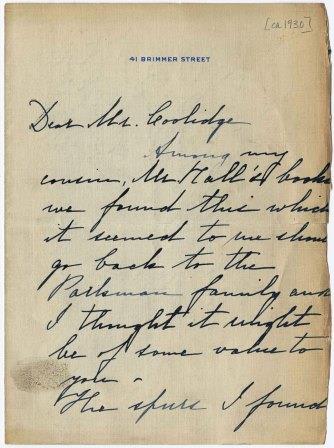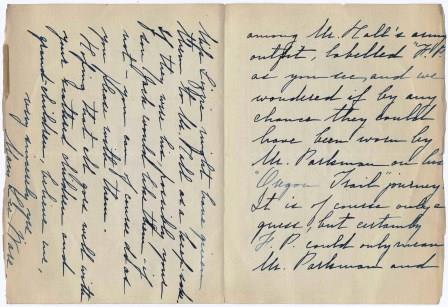By Susan Martin, Collections Services
The MHS recently acquired this letter by Mary Ware Hall about spurs belonging to famed historian Francis Parkman, possibly worn during his expedition on the Oregon Trail in 1846. To catalog the letter, I had to identify its writer, recipient, date, and subject. But not only is the letter undated, it didn’t come to us as part of a larger collection, so I had no context to help me. Fortunately, researching the people and the stories behind our manuscripts is all part of the fun.


The letter itself is fairly mundane. It reads:
Dear Mr. Coolidge
Among my cousin, Mr. Hall’s books we found this which it seemed to me should go back to the Parkman family and I thought it might be of some value to you.
The spurs I found among Mr. Hall’s army outfit, labelled “F.P.[”] as you see, and we wondered if by any chance they could have been worn by Mr. Parkman on his “Oregon Trail” journey. It is of course only a guess, but certainly F.P. could only mean Mr. Parkman and Miss Lizzie might have given them to Mr. Hall as a keep-sake. If they were his, possibly your son Jack would like them. If not, you can of course do as you please with them.
Hoping that all goes well with your scattered children and grand-children, believe me,
Very sincerely yrs.
Mary Lee Ware
Mary Lee Ware (1858-1937) was a noted philanthropist who lived at 41 Brimmer Street, Boston. She was easy enough to find. And Francis Parkman (1823-1893) is definitely a known quantity here at the MHS—not only do we hold books by and about Parkman, we also have collections of his papers (here, here, and here) and photographs.
Our cast of characters also includes Mr. Coolidge (the recipient), Mr. Hall (Ware’s cousin), Miss Lizzie, and Jack. My first step was to put together a family tree to trace the connections between the Wares, Halls, Parkmans, and Coolidges. The spurs had somehow made their way from Francis Parkman to Mr. Hall to Mary Lee Ware. Who was this mysterious Mr. Hall that connected Parkman and Ware? Ware’s aunt Harriet had married a Hall and had several sons, but most of them died as children. Francis Parkman’s mother Caroline had also been a Hall.
I found a clue in Parkman’s 1865 book Pioneers of France in the New World. He dedicated that book to the memory of three relatives “slain in battle”: Theodore Parkman, Robert Gould Shaw, and Henry Ware Hall. Henry Ware Hall (1839-1864), Parkman’s cousin, had served in the 51st Illinois Infantry Regiment and was killed in action at the Battle of Kennesaw Mountain, Ga. This military connection would explain Hall’s “army outfit,” where the spurs had been found.
Henry Ware Hall and Francis Parkman shared an uncle, Edward Brooks Hall—the same Hall who had married Mary Lee Ware’s aunt Harriet. So Henry, Francis, and Mary were all first cousins. Still with me?
So who was Mr. Coolidge, the Parkman family member to whom Ware sent the letter and the spurs? That question was a lot easier to answer. John Templeton Coolidge (1856-1945) was Parkman’s son-in-law. (Coolidge had a son with the same name, but he was undoubtedly the “Jack” mentioned in the letter.)
Identifying the letter’s recipient also helped me to assign an approximate date. Not only did the reference to Coolidge’s grandchildren confirm it was written later in his life, but if Ware was sending the spurs to him, I could probably make the assumption that he was the last (or oldest) surviving relative of that generation. Parkman had had two daughters who lived to adulthood—Coolidge’s wife Catherine and her older sister Grace. Most likely they had both already died, as well as Grace’s husband Charles P. Coffin, or else Ware might have sent the spurs to one of them.
Catherine died in 1900, Charles in 1927, and Grace in 1928. Mary Lee Ware herself died in 1937. So the letter was apparently written sometime between 1928 and 1937. The style of stationery and writing seem to correspond to that time.
I can only guess at the story behind the spurs. If I’m right that Mr. Hall is Henry Ware Hall, they may have been found among his things long after his death in the Civil War. Ware speculates that “Miss Lizzie” gave them to Hall. She is probably Francis Parkman’s unmarried sister Eliza Willard Shaw Parkman (1832-1905)—“Lizzie” to her brother—who lived with him at 50 Chestnut Street for the last twenty years of his life, just a few blocks away from Mary Lee Ware.

